Research on mobile charging robot: more than 20 companies have come in and have implemented in three major scenarios.
Mobile Charging Robot Research Report, 2024 released by ResearchInChina highlights the following:
Overview of mobile charging robot (development history, product classification, system structure, key technologies, etc.);
Characteristics of mobile charging robot market (policy environment, operation scenarios, marketization process, commercial value, main players, competitive edges of players, etc.);?
Mobile charging robot industry chain (market characteristics, technical requirements, main suppliers, etc. of key modules such as energy storage, autonomous driving, mechanical arm and operation platform);???
Mobile charging robot suppliers (product features, application scenarios, commercialization, etc. of over 20 Chinese and foreign mobile charging robot companies);
Development trends of mobile charging robot (market trends, technology trends, advantages and disadvantages for industry development, etc.).
1. From 2023 to 2024, mobile charging robot companies mushroom in China.??
Mobile charging robot is intelligent equipment for mobile charging. After an electric vehicle is parked in the parking space, via APP or other systems, the robot with charging function will automatically move to the vehicle to charge it. As a temporary and fast way to replenish vehicles, mobile charging robots will complement existing fixed charging, battery swap and wireless charging modes in the future to build an improved energy replenishment ecosystem for electric vehicles.???
From the perspective of development history, mobile charging robot started around 2015 and was first proposed by Tesla and Volkswagen. Chinese companies began to enter in 2020. By 2024, there will be more than 20 Chinese players, and their products will also become diversified and have function upgrades.???
2. Most mobile charging robot players come from OEMs, energy companies, robotics companies, and technology companies.
Mobile charging robots span multiple fields from autonomous driving and energy to robotics. Current players mainly come from OEMs, energy companies, robotics companies, and technology companies.??
 ?
?
① OEMs like Volkswagen and FAW Hongqi develop products around vehicle charging needs.
?Volkswagen has explored multiple mobile charging solutions, including mobile charging robot and mobile charging station. Its mobile charging robot works by dragging a charging pack. The fully automated robot is fitted with cameras, LiDAR and ultrasonic sensors. It can charge parked cars on its own using a mechanical arm and a 25kWh battery pack. However this solution is still in the prototype phase. One of the reasons why it has yet to be mass-produced is the high cost. This solution is equivalent to using two robots (one of which is a huge battery), and its manufacturing cost may be as high as an electric vehicle.????
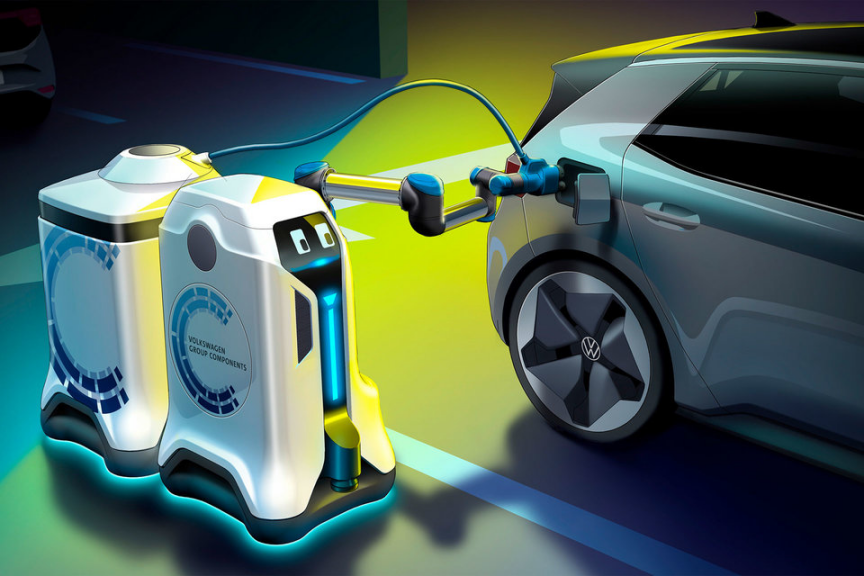
?FAW Hongqi trial-produced an intelligent mobile charging robot prototype in 2022. It integrates a mechanical arm, automation technology and a vision system for complex environments in all scenarios. Combined with robot control technology, it can plug in the gun to an electric vehicle and charge by itself, providing car owners with a more intelligent and more automatic charging experience.????
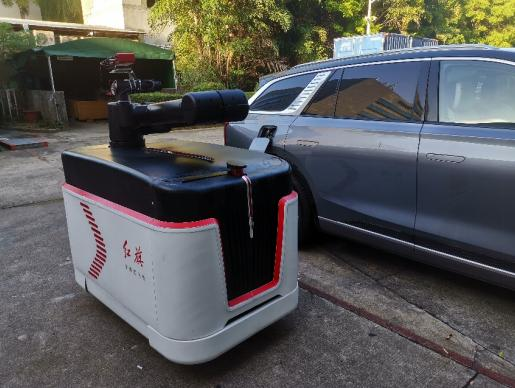
② Energy companies like Gotion High-Tech and Envision Group provide diverse energy extension services by virtue of? their resource advantages.
?Gotion EPLUS intelligent mobile energy storage charging pile is a brand-new product that integrates storage and charging, drives itself freely and moves agilely, providing fast charging services for new energy vehicles anytime and anywhere. It is produced by Anhui Yijianeng Digital Technology Co., Ltd., a subsidiary of Gotion High-Tech. As of April 2024, up to 1,000 EPLUS piles have been put into operation in 30 cities of China including Shanghai, Shenzhen, Hangzhou and Hefei, and it has been exported to the US, Japan, Germany, Singapore, Thailand, the Netherlands, Indonesia and other places.????
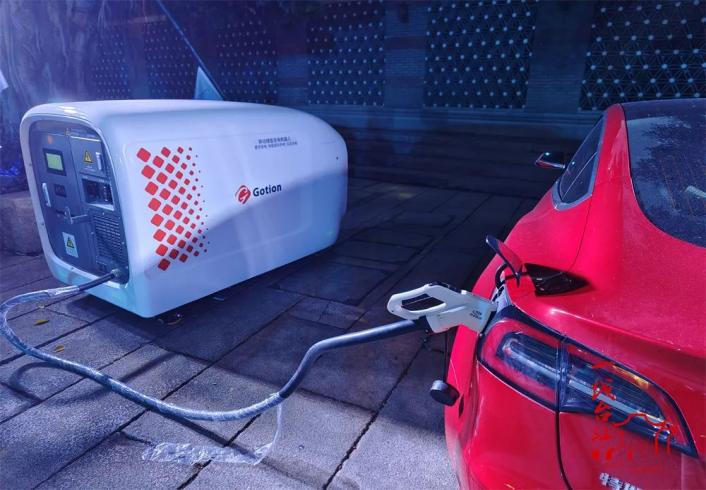
?Envision Group unveiled Mochi in 2021, a charging robot equipped with multiple sensors such as LiDAR, ultrasonic radar array, high-precision wheel speedometer, and inertial measurement unit. It can automatically find the path, drive itself, and accurately get to the parking space where the user summons it. When encountering an obstacle, it can come to a full stop from full speed only in 0.1 seconds, and automatically avoid the obstacle and arrive safely. Using Envision AESC’s automotive-grade safe batteries, Mochi can quickly charge a new energy vehicle with a range of about 600km to the full within 2 hours. It is adaptable to almost all mainstream electric models on the market.???
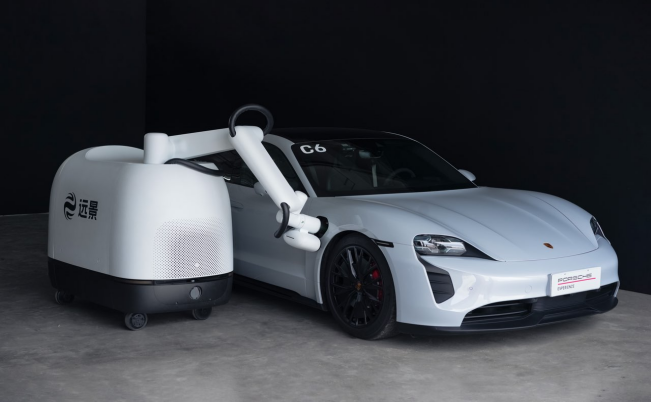
③ Robotics companies enable use of their products in the charging automation market segment relying on their technical strengths such as mechanical arm and control system. Typical companies include Xiangyi Automation Technology and Ocean&Macro Intelligent Technology.
?The mobile charging robot jointly developed by Xiangyi Automation Technology and AUBO can charge electric vehicles at any time. This product features a working radius of 1350mm, a repeated positioning accuracy of ±0.03mm, and ±360° rotation of each joint. It can accurately recognize the charging interface and automatically plug in and pull out the charging gun.???
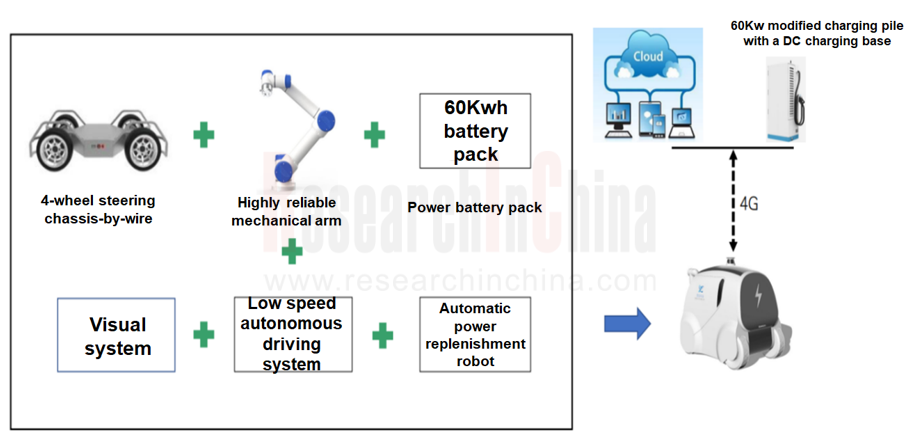
?Following the innovation sharing idea of mobile phone power banks, the parking lot mobile power bank solution developed by Ocean&Macro Intelligent Technology combines with the autonomous mobile robot (AMR) to flexibly transport rechargeable batteries. It is the product of the integration of charging piles and mobile robots. In 2023, Ocean&Macro Intelligent Technology’s first new energy mobile charging robots came into use, providing a 206kWh battery that can charge 4-6 vehicles. With the maximum charging power up to 80KW, they enable a range of 200km for vehicles with a 20-minute charge.?????
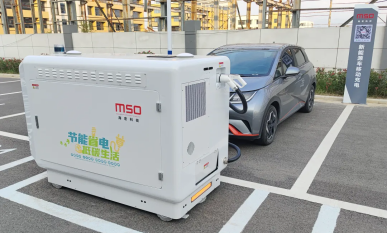
④Other technology companies integrate technologies and resources around charging scenarios and deploy products in the mobile charging segment. Typical companies include SATOR Tech and Zhaozhuang Technology.
?SATOR mobile charging robot with 60kW charging power and a 70kWh CATL battery can achieve 10,000 cycles. In addition, it packs an automotive-grade battery with DC fast charging, allowing for a charge to 80% in half an hour. The power module output voltage range is wide, covering vehicles with 800V systems.?
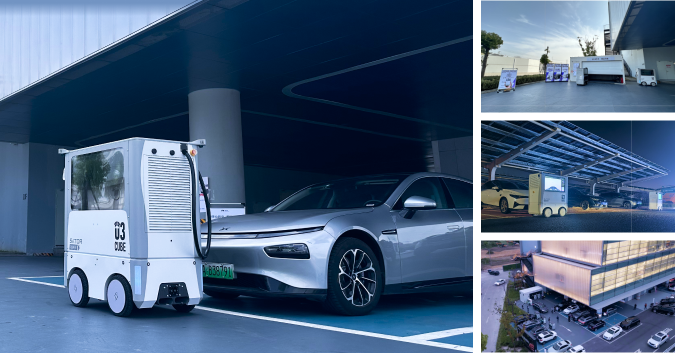 ?
?
3. Mobile charging robots have been implemented in three major scenarios: emergency energy replenishment, regular energy replenishment, and accompanying energy replenishment.
Mobile charging robots are primarily used in energy replenishment scenarios, including emergency energy replenishment, regular energy replenishment, and accompanying energy replenishment.?
① Emergency energy replenishment often come into use in scenarios where a vehicle accidentally loses power while travelling.
Application case: The mobile charging robot of State Grid Wuhan Power Supply Company can be deployed according to the load of surrounding charging stations, and can also provide emergency rescue for on-road vehicles that need to be charged for the moment: within 2 kilometers, the robot can directly drive itself there; as for temporary support beyond 2 kilometers, it is transported to the scene by a vehicle.??
② Regular energy replenishment is applied in the most scenarios including highway service zones, community parking lots, shopping mall underground garages, scenic spot parking lots and industrial campuses, of which it is the most common in highway service zones.?
Application case: During the National Day holiday in 2023, Zhejiang, as the venue for the 19th Asian Games, actively proposed and implemented innovative energy replenishment solutions and put into use mobile charging robots in highway service zones. In some service zones such as Jiaxing, Dongyang, Yuyao, Xiaoshan and Changan, SATOR mobile charging robots were deployed. After parking, car owners can summon the mobile charging robot via their mobile phone to charge their car, avoiding many problems caused by waiting in line for charging.?????
③ Accompanying energy replenishment often acts as an ancillary charging facility for autonomous vehicles or new energy vehicles.
Application case: Fulongma’s mobile charging vehicle provides road rescue services along with large charging vehicles.??
4. Mobile charging robot + AVP/ultra-fast charging/commercial vehicle is expected to become the next application trend.
As autonomous driving and ultra-fast charging technologies come into service, mobile charging robots are expected to be applied in new scenarios.
① Mobile charging robot + AVP
After AVP is combined with the charging function, the system will automatically allocate the parking space and charging space according to state of charge. For example, when a vehicle needing a charge enters the site and the system determines that it needs to be charged, the system will automatically guide the vehicle to the charging location. Then the charging device will automatically communicate with the vehicle's charging mechanism and start charging. After charging the vehicle to the set upper limit, the system will move it to a general parking space and then charge the next electric vehicle.????
At CES 2024 in January 2024, Bosch and Volkswagen subsidiary Cariad demonstrated how to achieve fully automated charging of electric vehicles in parking lots in the future. This concept is similar to the Automated Valet Parking previously cooperated with Mercedes-Benz. As long as the driver drives a car that supports this function and gets off the car at the drop-off area of the designated parking lot, he/she can activate the automated parking function via the App, and the system will take over all the follow-up steps until the user picks up the car and leave. The user can summon the car to the pick-up area via?App.?
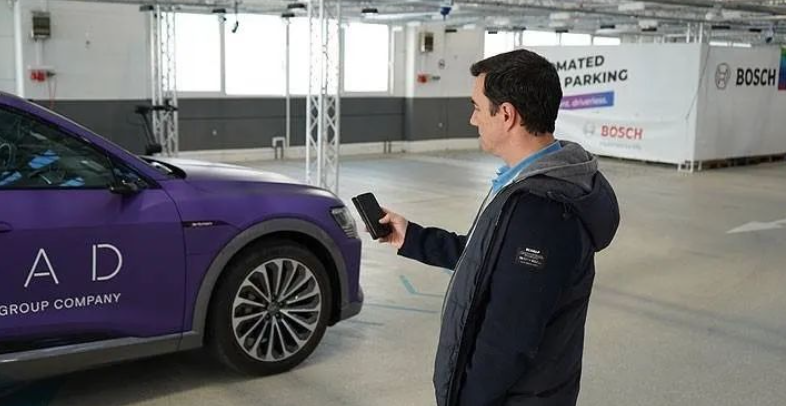
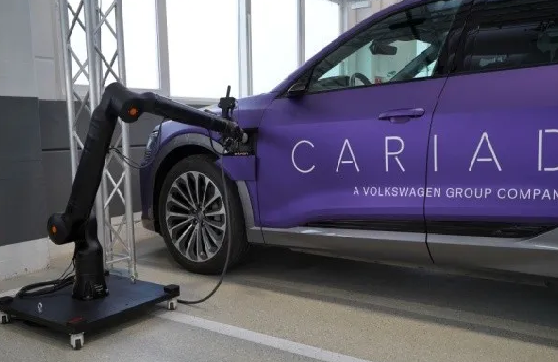
② Mobile charging robot + ultra-fast charging
Since 800V new energy vehicles were unveiled in 2023, multiple brands like BYD, Avatr, Xpeng and Denza have achieve mass production, which then pushes up the demand for ultra-fast charging technology.????
In the field of mobile charging, Lotus was the first to apply ultra-fast charging. In August 2023, Lotus Automatic Charging Robot and Solar Storage Supercharging Station settled in Fuyang District, Zhejiang. The supercharging station is equipped with a liquid-cooled supercharging system which supports fully liquid-cooled high-power charging architecture. With the maximum power output of 650kW, it only takes 20 minutes to charge Eletre from 10% to 80%. Differing from conventional mobile charging robots, it cannot move and allow “the pile to find people”, in spite of adopting automation technology.?
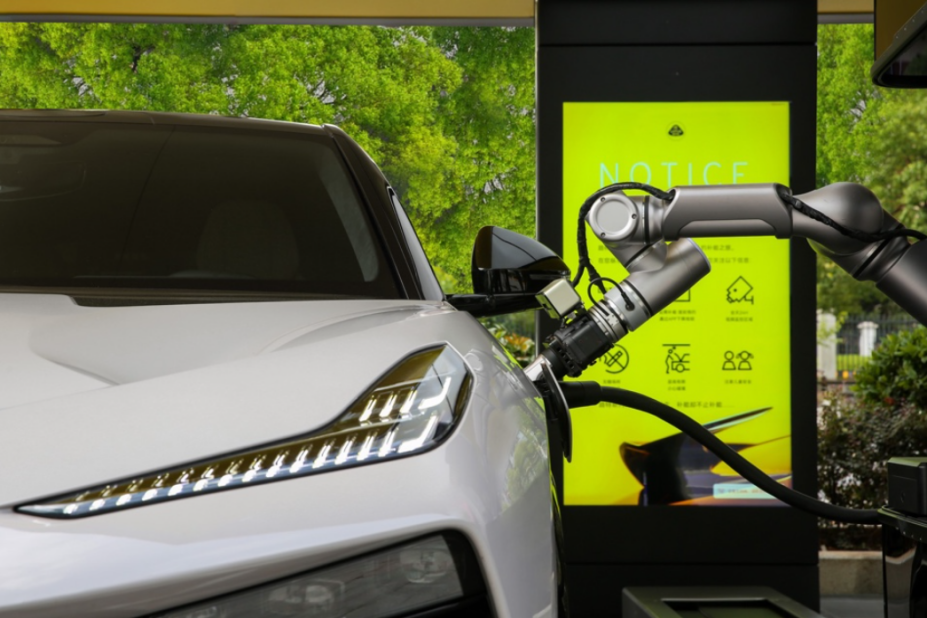 ??
??
SATOR Tech and DHForce have rolled out mobile charging robots that support high-voltage fast charging. SATOR mobile charging station can cover 800V system vehicles, and is equipped with both liquid cooling and low-temperature heating systems, and automotive-grade batteries that enable a charge to 80% with DC fast charging in half an hour. DHForce’s integrated mobile supercharging robot is compatible with 800V platforms and provides 70kWh/80kWh stable and fast charging. The launch of above solutions makes it possible to apply ultra-fast charging in mobile charging robots.????
③ Commercial vehicle + application in closed scenarios
Due to large size and inconvenient scheduling, commercial vehicles need mobile charging. In closed scenarios such as campuses, factories and airports, the requirements for the autonomous driving capabilities of charging vehicles are not high, so the demand for mobile energy replenishment in commercial vehicle + closed scenarios is expected to expand.?
At this stage, in closed campuses automatic charging services are generally provided in the form of fixed charging station + automatic mechanical arm.?
?Xiangyi Automation Technology’s automatic charging robot with Xiaoyu 2.0, Yutong’s new-generation robot bus, entered the Changsha Airport apron for testing. According to the set threshold, when the battery level is lower than a certain SOC value, the vehicle can drive itself to the automatic charging spot. After the autonomous driving system determines that the vehicle is ready for charging, it sends a charging instruction to the automatic charging robot, and the automatic charging robot accurately locates the vehicle charging socket through vision localization and then precisely inserts the charging gun into the vehicle charging socket, without needing to change the charging socket and with strong adaptability.?????
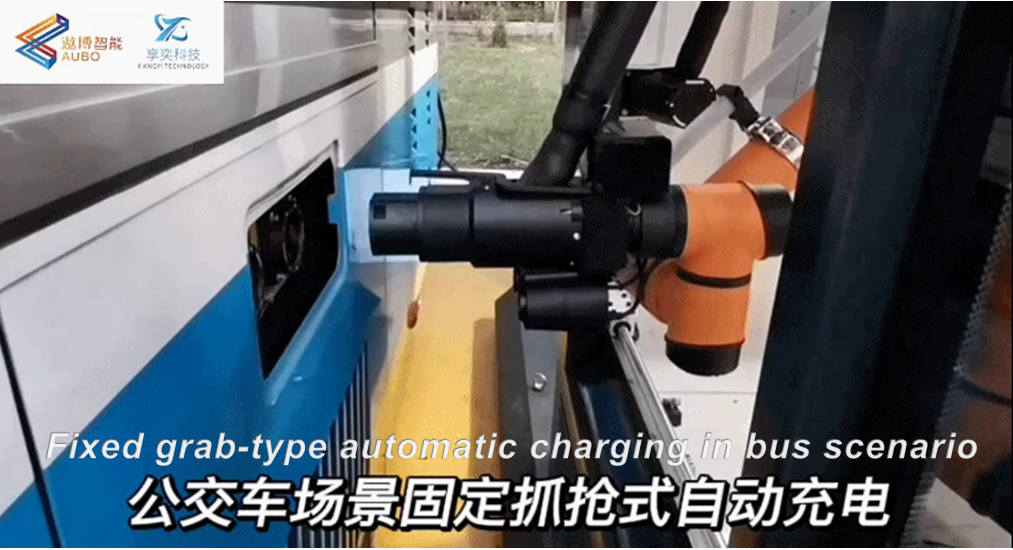
?TELD intelligent flexible charging robot consists of two parts: an intelligent flexible charging robot and an on-board electric base. Based on TELD’s two-layer protection and flexible charging, it is a solution that integrates multi-axis movement and accurate recognition to automatically charge electric vehicles. The system has a service life of up to 150,000 times, 15 times that of conventional charging terminals. With smart chip + laser detection, it accurately locates the charging interface, effectively improving autonomous operation in campus scenarios. It is suitable for commercial vehicles, engineering vehicles and special vehicles.?

In the future, as battery energy storage efficiency improves, mobile charging robots are expected to be applied in commercial vehicle + closed campus scenarios.
Intelligent Driving Simulation and World Model Research Report, 2025
1. The world model brings innovation to intelligent driving simulation
In the advancement towards L3 and higher-level autonomous driving, the development of end-to-end technology has raised higher re...
Autonomous Driving Map (HD/LD/SD MAP, Online Reconstruction, Real-time Generative Map) Industry Report 2025
Research on Autonomous Driving Maps: Evolve from Recording the Past to Previewing the Future with "Real-time Generative Maps"
"Mapless NOA" has become the mainstream solution for autonomous driving s...
End-to-End Autonomous Driving Research Report, 2025
End-to-End Autonomous Driving Research: E2E Evolution towards the VLA Paradigm via Synergy of Reinforcement Learning and World Models??The essence of end-to-end autonomous driving lies in mimicking dr...
Research Report on OEMs and Tier1s’ Intelligent Cockpit Platforms (Hardware & Software) and Supply Chain Construction Strategies, 2025
Research on intelligent cockpit platforms: in the first year of mass production of L3 AI cockpits, the supply chain accelerates deployment of new products
An intelligent cockpit platform primarily r...
Automotive EMS and ECU Industry Report, 2025
Research on automotive EMS: Analysis on the incremental logic of more than 40 types of automotive ECUs and EMS market segments
In this report, we divide automotive ECUs into five major categories (in...
Automotive Intelligent Cockpit SoC Research Report, 2025
Cockpit SoC research: The localization rate exceeds 10%, and AI-oriented cockpit SoC will become the mainstream in the next 2-3 years
In the Chinese automotive intelligent cockpit SoC market, althoug...
Auto Shanghai 2025 Summary Report
The post-show summary report of 2025 Shanghai Auto Show, which mainly includes three parts: the exhibition introduction, OEM, and suppliers. Among them, OEM includes the introduction of models a...
Automotive Operating System and AIOS Integration Research Report, 2025
Research on automotive AI operating system (AIOS): from AI application and AI-driven to AI-native
Automotive Operating System and AIOS Integration Research Report, 2025, released by ResearchInChina, ...
Software-Defined Vehicles in 2025: OEM Software Development and Supply Chain Deployment Strategy Research Report
SDV Research: OEM software development and supply chain deployment strategies from 48 dimensions
The overall framework of software-defined vehicles: (1) Application software layer: cockpit software, ...
Research Report on Automotive Memory Chip Industry and Its Impact on Foundation Models, 2025
Research on automotive memory chips: driven by foundation models, performance requirements and costs of automotive memory chips are greatly improved.
From 2D+CNN small models to BEV+Transformer found...
48V Low-voltage Power Distribution Network (PDN) Architecture and Supply Chain Panorama Research Report, 2025
For a long time, the 48V low-voltage PDN architecture has been dominated by 48V mild hybrids. The electrical topology of 48V mild hybrids is relatively outdated, and Chinese OEMs have not given it suf...
Research Report on Overseas Cockpit Configuration and Supply Chain of Key Models, 2025
Overseas Cockpit Research: Tariffs stir up the global automotive market, and intelligent cockpits promote automobile exports
ResearchInChina has released the Research Report on Overseas Cockpit Co...
Automotive Display, Center Console and Cluster Industry Report, 2025
In addition to cockpit interaction, automotive display is another important carrier of the intelligent cockpit. In recent years, the intelligence level of cockpits has continued to improve, and automo...
Vehicle Functional Safety and Safety Of The Intended Functionality (SOTIF) Research Report, 2025
Functional safety research: under the "equal rights for intelligent driving", safety of the intended functionality (SOTIF) design is crucial
As Chinese new energy vehicle manufacturers propose "Equal...
Chinese OEMs’ AI-Defined Vehicle Strategy Research Report, 2025
AI-Defined Vehicle Report: How AI Reshapes Vehicle Intelligence?
Chinese OEMs’ AI-Defined Vehicle Strategy Research Report, 2025, released by ResearchInChina, studies, analyzes, and summarizes the c...
Automotive Digital Key (UWB, NearLink, and BLE 6.0) Industry Trend Report, 2025
Digital key research: which will dominate digital keys, growing UWB, emerging NearLink or promising Bluetooth 6.0?ResearchInChina has analyzed and predicted the digital key market, communication techn...
Integrated Battery (CTP, CTB, CTC, and CTV) and Battery Innovation Technology Report, 2025
Power battery research: 17 vehicle models use integrated batteries, and 34 battery innovation technologies are released
ResearchInChina released Integrated Battery (CTP, CTB, CTC, and CTV)and Battery...
AI/AR Glasses Industry Research Report, 2025
ResearchInChina released the " AI/AR Glasses Industry Research Report, 2025", which deeply explores the field of AI smart glasses, sorts out product R&D and ecological layout of leading domestic a...